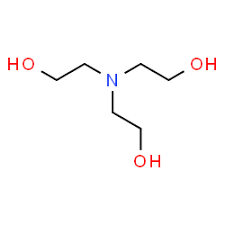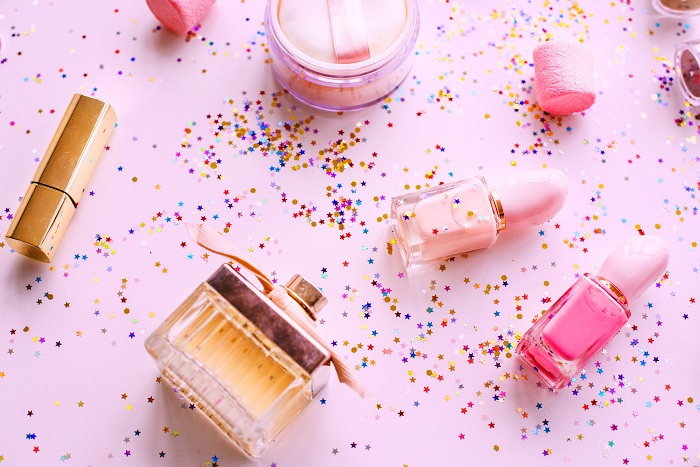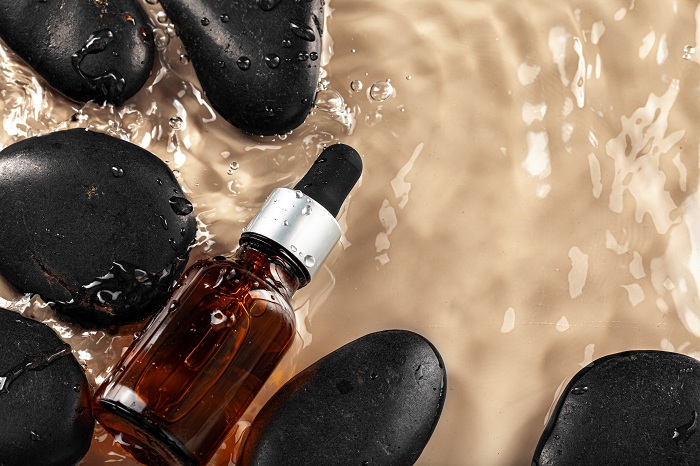Many often recommend only purchasing skincare products that contain pronounceable ingredients. In a way, this is good advice, since many of those complex, chemical-sounding words really aren’t great for your skin.
However, there’s also a long list of lesser-known ingredients that aren’t harmful in any way. In fact, they’re extremely important for maintaining that product’s integrity. Without them, that product wouldn’t exist. One such ingredient is triethanolamine. You might not have heard of this one before, but that doesn’t necessarily mean that it should be avoided. Here’s why…
Contents
What is Triethanolamine?

Triethanolamine (TEA) is a clear, colorless, liquid compound. It has a slight ammonia-like scent due to the fact that it’s created through a chemical reaction that occurs when air-derived ammonia comes into contact with ethylene oxide, a byproduct from the petroleum industry.
Being a non-active compound, TEA doesn’t actually have any effect on the skin. Instead, it’s added to cosmetic products for other purposes, which you’ll learn about soon.
Since triethanolamine is only used in very small quantities (most countries have regulations that keep concentrations between 2.5% and 5%), it often appears towards the end of an ingredients list.
Other Forms of Triethanolamine
There are two other cosmetic compounds that are very similar to triethanolamine; diethanolamine and ethanolamine. They’re also created when ethylene oxide gases mix with ammonia gases, and both have been approved for use in cosmetics.
That said, whether it’s triethanolamine or one of the other two forms being produced, the compound needs to be tested for 99% purity before it can be used in skincare product formulas.
Benefits of Triethanolamine in Cosmetic Products
As mentioned, triethanolamine doesn’t actually do anything for your skin. Instead, it’s used in the production process to stabilize, emulsify, and thicken products. Let’s take a closer look at how it works:
Stabilizes pH Levels
The skin’s natural pH level sits at around 4.7 [1], and it’s important to keep this as constant as possible. Many of the most common skin conditions out there, from oiliness and acne to aging, redness, irritation, and psoriasis, are caused when the skin’s pH falls out of balance.
With this in mind, you would think that skincare products would have a pH that’s as close to the skin’s as possible. Unfortunately, this isn’t always the case. Many active ingredients are either acidic or alkaline. This affects the pH of the finished product, which then has an impact on your skin. Cleansers are particularly prone to doing this, but the majority of cosmetics out there contain ingredients that will disrupt your skin’s pH level.

This is where triethanolamine comes in. Triethanolamine works as a pH adjuster. Whether a formula is on the acid or alkaline end of the scale, triethanolamine helps to keep things neutralized. These pH adjuster properties not only make a formula safer and non-irritating for your skin, but they also help to protect it and keep it more stable in the long term, therefore extending its shelf-life.
Emulsifies Skincare Products
Many of the best skincare formulas out there contain both oil and water. As you know, these two ingredients don’t mix well. Add these ingredients to skincare formulations without an emulsifier and they’ll separate. The water would sit at the top, while the oil would sink to the bottom, giving that product an uneven texture.
There are several emulsifiers out there that are used by the cosmetics industry, with triethanolamine being one of the most popular. The structure of triethanolamine has both hydrophilic and hydrophobic properties. This means that it’s able to bind with both water and oil.
As a result, when triethanolamine is added to a formulation containing both oil and water, it binds the ingredients together. This allows that formula to mix as intended, resulting in a usable formula.
Thickens Skincare Formulations
The texture of skin care products is and isn’t important. When it comes to how effective a product is, all that really matters is the ingredients. That said, nobody wants to use a product that’s overly runny, or one that’s lumpy.
In these cases, a thickening agent is required. This is yet another one of the benefits provided by triethanolamine. It adds body to skincare formulations, reducing surface tension to give them a thicker and more luscious texture that makes them pleasant to apply.
While this may seem like quite a superficial benefit, it’s an important one. The texture of a product hugely influences whether or not a consumer would buy that product again, making it important for brands to get this right.

Other Uses of Triethanolamine
Triethanolamine is used in a wide range of skincare formulations. From cleansers and sunscreens to fragrances and body products, its pH adjuster properties, in particular, make it very useful. You’ll also find the ingredient in many makeup products and hair dyes, while the textile industry uses it as a lubricant for various materials.
Is Triethanolamine Safe?
There are some reviews out there that make triethanolamine sound downright scary. Some say that the ingredient has cancer-causing properties, but, fortunately, scientific research has clarified things. Turns out, the ingredient is only potentially harmful when it’s used in a formulation with N-nitrosating agents, like nitrates. When these ingredients are combined, possibly carcinogenic nitrosamines could form.
Aside from the way in which it reacts with N-nitroso compounds, you don’t need to worry about the safety of triethanolamine. Just about all of the research out there has found inadequate evidence to link triethanolamine to cancer, so long as it has been formulated in amounts that meet recommended guidelines.
Guidelines from the Cosmetic Ingredient Review: Rinse-Off and Non-Rinse Off Products
The safety guidelines for triethanolamine concentrations vary depending on the type of product it is used in. Rinse-off products, such as cleansers, aren’t quite as important. They don’t remain on the skin for long periods of time, meaning that absorption isn’t an issue. As a result, their triethanolamine content is unlikely to have an effect on your skin.
However, when it comes to products that remain on the skin, from makeup to anti-aging creams, it’s important that the safety guidelines are followed. In the USA, this means that no more than 5% triethanolamine can be used, while EU countries have a limit of 2.5%.
What Happens if Safety Guidelines Aren’t Followed?
If triethanolamine is used at a concentration higher than 5%, then this puts you at risk of allergies and skin irritation. That said, evidence regarding this toxicity is rare. Since the ingredient isn’t usually used at such high concentrations, the exact risk, especially when it comes to skin irritation, is relatively unknown.

However, what the experts do know is that humans who manufacture triethanolamine do often experience skin irritation, along with eye and respiratory problems. That’s because they have a high exposure to the ingredient, something that the average skincare user won’t experience. They also usually work in a warm environment, which exacerbates any problems. Fortunately, this irritation is usually non-existant if the proper safety protocols are followed during the manufacturing process.
Environmental Impact
Many ingredients out there offer a variety of skin benefits, but at an environmental cost. The journal ‘Reviews of Environmental Contamination and Toxicity’ found that triethanolamine poses a minimal environmental risk [2]. This is something that’s becoming increasingly important to consumers these days, so it’s good to know that triethanolamine doesn’t produce any negative consequences for the planet.
FAQs

Is triethanolamine a carcinogen?
On its own, triethanolamine is not a carcinogen. However, when used with N-nitrosating agents, it could possibly develop carcinogenic properties. This is why it’s important to always scrutinize the ingredients in a product before applying anything to your skin.
Is triethanolamine toxic to eat?
Triethanolamine is not safe to be eaten. However, it’s used by the food industry in indirect ways, such as when they produce food packaging.
Is triethanolamine safe for sensitive skin?
In most cases, yes, triethanolamine is safe and won’t cause any issues for those with sensitive skin. However, if your skin is hypersensitive, then evidence shows that using triethanolamine could produce a range of issues. Performing a patch test on your skin first is always a good idea – this will also ensure that your skin won’t react to any of the other ingredients in that product.
Is triethanolamine dangerous in hand sanitizer?
At low concentrations, triethanolamine is safe, even in a hand sanitizer. However, when used in high concentrations, the ingredient could possibly be toxic.
Conclusion
At first glance, triethanolamine may seem like a bit of a pointless ingredient. After all, it doesn’t actually offer any direct benefits to the skin. However, dig a little deeper and you’ll learn that this ingredient actually plays an important role in the cosmetics industry. Even though it may not be used in high concentrations, it’s vital for keeping products stable, while also giving them a texture that makes them usable and enjoyable.
While there may be many similar ingredients out there, triethanolamine is one of the safest, making this an ingredient that you definitely don’t need to avoid.
References
[1] https://pubmed.ncbi.nlm.nih.gov/18489300/
[2] https://link.springer.com/chapter/10.1007/978-1-4612-2272-9_1